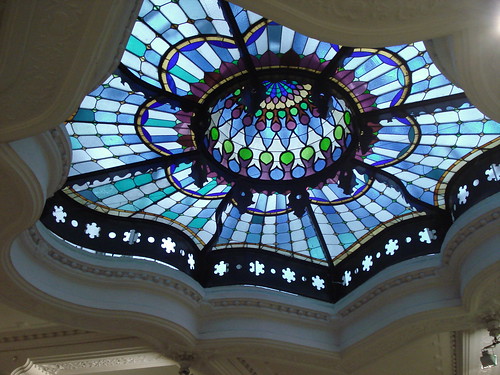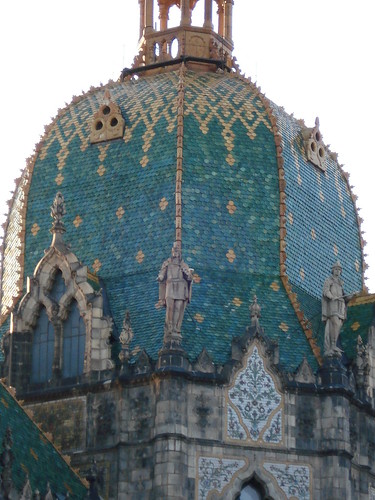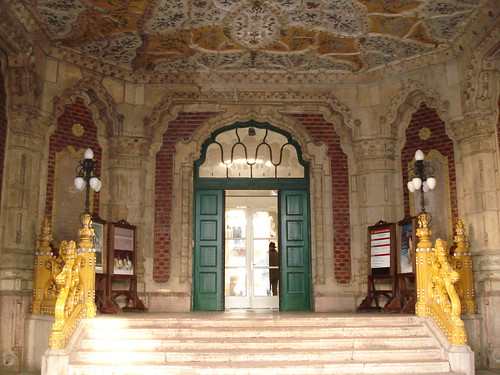 |
| Stained glass cupola |
Budapest is one of Europe's most beautiful cities. Clinging to the banks of the Danube and really two cities with different characters, Buda and Pest, it boats a magnificent built heritage with many examples of art nouveau, modernist, classicist and soviet style architecture. The Museum of Applied Arts on Ulloi Utca is just one of the city's art nouveau treasures, designed by Odon Lechner and opened by Emperor Franz Joseph on 25th October 1896.
I discovered the museum on my first visit to Budapest in 1995 and have always made a point of going there whenever I return. In 1995, Hungary was still in the early stages of transition from the old political regime and the building was somewhat dusty but packed full of treasures including unexpected works by Joseph Hoffman, Margo McDonald McIntosh, Charles Rennie McIntosh and of course the work of Hungarian ceramics genius Vilmos Zsolnay. The approach to display was somewhat serendipitous with many items on display, some labelled some not and all under the watchful eye of a group of those elderly ladies you used to find in central and eastern European museums with perfectly coiffed hair, a cardigan worn over the shoulders and a stern look. Some of these ladies still survive and I have to admit I have found some of them to be extremely helpful and friendly once the protective outer shell is broken!
 |
| Main dome with distinctive green tiles |
Later visits saw the Museum taking a more modern approach to exhibiting its collection with fewer items on display, more information (including in English) and interesting themed approaches being taken. I have to admit though, to a little longing for access to the range of treasure on view in 1995 - ceramics, textiles, metalworks, chairs and other furnishings.
But what of the building? The museum was the idea of one Floris Romer who was inspired by the establishment of the major museums in London's South Kensington and by those of Vienna. Romer must have been persuasive because in 1872 the government set up a fund to acquire objects for an applied arts museum and by 1890, the Ministry of Religion and Public Education felt strongly enough to announce an architectural competition for a National Royal Museum and a School of Applied Arts. 12 sets of designs were awarded and those of Odon Lechner and Gyula Partos were awarded first prize.
The building sparked passion both for and against it. The competition judges praised the designs for adopting an individual, free architectural concept in keeping with its intended use and for its extensive use of Hungarian majolica. However not everyone loved it and as the art nouveau style receded in the 1920's some of the interior paintings of the museum were destroyed. During the Second World War, further damage was sustained to the main entrance, main cupola and attic. Yet more damage was done during the 1956 uprising. After the war some repairs were carried out although not all were faithful to the original designs. More sensitive restoration were carried out after 1989 but the building is in need of further work and in 2012 a European Union funded competition was launched to attract proposals for restoration.
The building still has a stunning green tiled roof with gold coloured decorations, the dome of which is visible from a considerable distance, but my favourite part is the dramatic entrance lobby pictured at the bottom of this post. The highly patterned ceiling, the regal bannister and low steps draw the visitor towards the relatively small main doors which then open up into a moorish style interior. The museum is arranged over terraced floors looking down into a central indoor courtyard which is used for music and performance as well as for exhibitions. And of course, some of the most stunning views can be had by looking up at the stained glass cupola. It is not exaggeration to say that the building gives the exhibits a good run for its money, ensuring that the memory of Lechner and his colleague Partos live on.
 |
| Inner courtyard and upper galleries of the museum |
Lechner was born in Pest in 1845 and is acknowledged as the leading Hungarian art nouveau architect. The esteem with which he is held is demonstrated by the opinion of leading architectural historian Nikolaus Pevsner who compared Lechner to Gaudi. Other examples of his work can still be seen in Budapest including the Postal Savings Bank on Hold Utca and the tomb of the Schmidl family in the Kozma Street Cemetery. Partos, born in the same year as Lechner was also an accomplished architect. He worked with Lechner on the Town Hall at Szeged and the Kecskemet City Hall, both in Hungary.
My picture post series usually features just one photograph per post. I couldn't resist including more here. For more photographs of Budapest see here.
 |
| Main entrance, restored in 2010 |

No comments:
Post a Comment